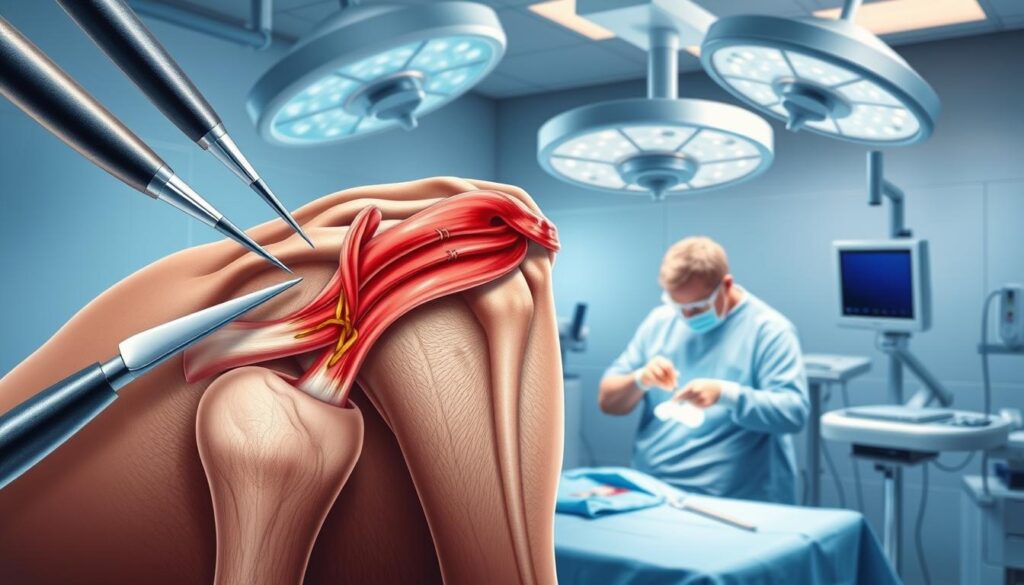Best treatment options for a supraspinatus tendon tear.
Table of Contents
If you’re dealing with a supraspinatus tendon tear, you’re likely searching for the most effective treatment options to alleviate your symptoms and restore shoulder function.
A tendon tear in the supraspinatus muscle can be painful and debilitating, affecting your daily activities and overall quality of life.

Fortunately, various treatment options are available to manage and heal this condition. This article will provide an overview of the best approaches, helping you make informed decisions about your care.
Key Takeaways
- Understanding the causes and symptoms of a supraspinatus tendon tear
- Exploring conservative treatment options for managing pain and inflammation
- Discussing surgical interventions for severe or persistent tears
- Learning about rehabilitation exercises to restore shoulder function
- Discovering the importance of proper diagnosis and timely treatment
Understanding the Anatomy and Function of Your Shoulder
To comprehend the impact of a supraspinatus tendon tear, it’s essential to first understand the shoulder’s overall anatomy. Your shoulder is a complex structure made up of bones, tendons, and muscles that work together to provide a wide range of motion.
The Role of the Rotator Cuff
The rotator cuff is a group of muscles and tendons surrounding the shoulder joint, keeping the head of your upper arm bone firmly within the shallow socket of the shoulder. The rotator cuff plays a crucial role in stabilizing the shoulder joint and enabling movements such as lifting and rotating your arm. A healthy rotator cuff is vital for maintaining shoulder function.
How the Supraspinatus Tendon Works
The supraspinatus tendon is one of the four tendons that make up the rotator cuff. It is located at the top of the shoulder joint and plays a key role in controlling arm movements, particularly abduction – the action of lifting your arm out to the side. The supraspinatus tendon works in harmony with other rotator cuff tendons to ensure smooth motion.
Why This Tendon Is Prone to Injury
The supraspinatus tendon is susceptible to injury due to its location and function. Repetitive strain, age-related wear, and acute injuries can all contribute to tendon damage. Understanding these risk factors can help in preventing injuries and managing conditions like a supraspinatus tendon tear.
Recognizing a Supraspinatus Tendon Tear
Understanding the signs of a supraspinatus tendon tear is crucial for timely medical intervention. You might be experiencing this condition if you’re feeling persistent shoulder pain, especially when performing overhead activities or lifting objects.
Common Symptoms and Warning Signs
Common symptoms include pain in the shoulder that radiates down the arm, weakness when rotating the arm, and a reduction in the range of motion. You may also experience pain at night, especially when lying on the affected shoulder.
Risk Factors That Increase Vulnerability
Certain factors increase your risk of experiencing a supraspinatus tendon tear. These include age, repetitive overhead activities, and previous shoulder injuries. The table below outlines these risk factors and their implications.
| Risk Factor | Description | Implication |
| Age | Tendon degeneration over time | Increased likelihood of tear |
| Repetitive Overhead Activities | Continuous strain on the tendon | Wear and tear leading to potential tear |
| Previous Shoulder Injuries | Compromised tendon integrity | Higher risk of further injury |
When to Seek Medical Attention
If you’re experiencing persistent shoulder pain or weakness, it’s essential to seek medical attention. Early diagnosis can significantly improve treatment outcomes for a supraspinatus tendon tear.
Diagnosis Methods for Supraspinatus Tendon Tears
The diagnosis of supraspinatus tendon tears relies heavily on both physical examination and advanced imaging techniques. A comprehensive diagnostic approach ensures that you receive an accurate assessment of your condition, which is crucial for determining the best treatment plan.
Clinical Examination Techniques
Clinical examination techniques are the first step in diagnosing a supraspinatus tendon tear. Your healthcare provider will assess your shoulder’s range of motion, strength, and pain levels through specific maneuvers. For instance, the drop arm test is commonly used to evaluate the integrity of the supraspinatus tendon. If you experience pain or weakness during these tests, it may indicate a tear.
Imaging Studies: MRI, Ultrasound, and X-rays
Imaging studies play a vital role in confirming the diagnosis. Magnetic Resonance Imaging (MRI) is particularly useful for visualizing soft tissue injuries, including tendon tears. Ultrasound is another valuable tool, offering dynamic assessment of the tendon’s movement. While X-rays are not directly used to diagnose tendon tears, they can help rule out other causes of shoulder pain, such as fractures or arthritis.Orthopedic experts note that MRI is the gold standard for detecting rotator cuff tears, offering excellent sensitivity and specificity.
Understanding Your Tear Classification
Once a supraspinatus tendon tear is diagnosed, it’s classified based on its severity. The classification helps guide treatment decisions. Tears can be partial or full-thickness, with the latter being more severe. Understanding your tear classification is essential for discussing treatment options, including the potential need for orthopedic surgery or the feasibility of shoulder rehabilitation programs.
Conservative Treatment Options for Supraspinatus Tendon Tear
The initial approach to treating a supraspinatus tendon tear often involves conservative methods aimed at alleviating symptoms and promoting recovery. These non-surgical interventions are designed to help manage pain, improve function, and potentially avoid the need for surgery.
RICE Protocol Implementation
The RICE protocol, which stands for Rest, Ice, Compression, and Elevation, is a fundamental first step in treating a supraspinatus tendon tear. Rest helps prevent further injury, while ice reduces pain and inflammation. Compression and elevation also help minimize swelling.
Pain Management Strategies
Effective pain management is crucial in the initial stages of treatment. This can include the use of over-the-counter pain relievers, such as NSAIDs, and potentially corticosteroid injections for more severe pain.
Activity Modification Guidelines
Modifying activities to avoid exacerbating the condition is essential. This includes avoiding heavy lifting, overhead activities, and any movements that aggravate the pain.
Non-Surgical Medical Interventions
Physical therapy is a key component of conservative treatment, focusing on strengthening the shoulder muscles and improving flexibility. Other interventions may include ultrasound therapy and electrical stimulation.
| Treatment | Description | Benefits |
| RICE Protocol | Rest, Ice, Compression, Elevation | Reduces pain and inflammation |
| Pain Management | NSAIDs, Corticosteroid injections | Manages pain effectively |
| Activity Modification | Avoiding aggravating activities | Prevents further injury |
Physical Therapy and Rehabilitation Exercises
Physical therapy is a cornerstone in the treatment of supraspinatus tendon tears, helping you regain shoulder function. A well-structured rehabilitation program is crucial for restoring strength, improving range of motion, and ensuring a successful recovery.
Initial Phase: Pain Control and Gentle Movement
The initial phase focuses on pain management and gentle mobilization. You will start with passive exercises where a therapist moves your shoulder, gradually progressing to active movements as your pain allows. Techniques such as pendulum exercises and wall climbing can help improve your range of motion without straining the tendon.
Intermediate Phase: Strengthening Protocols
As your shoulder becomes more comfortable, the focus shifts to strengthening the rotator cuff and surrounding muscles. Resistance band exercises and light weight training are commonly used. It’s essential to strengthen the muscles around the shoulder joint to support the healing tendon and improve overall shoulder stability.
Advanced Phase: Functional Restoration
In the advanced phase, the goal is to restore functional ability, enabling you to perform daily activities and sports-specific movements. Exercises become more challenging, incorporating plyometric training and advanced strengthening protocols. This phase is critical for returning to pre-injury activity levels.
Home Exercise Programs
A home exercise program is a vital component of your rehabilitation. Consistency is key; you should perform these exercises as directed by your therapist to maintain progress and prevent re-injury. A sample home exercise routine might include:
| Exercise | Repetitions | Frequency |
| Shoulder Rolls | 10-15 | 3 times a day |
| Wall Climbing | 10 reps | Twice a day |
| Resistance Band Exercises | 3 sets of 10 | Daily |
By following a structured rehabilitation program and adhering to your home exercise routine, you can achieve a full recovery and return to your normal activities.
Surgical Interventions When Conservative Treatment Fails
When conservative treatments don’t provide the desired relief, surgical interventions become a viable option for addressing supraspinatus tendon tears. As a patient, it’s essential to understand the various surgical options available and what to expect from the process.
Arthroscopic Repair Techniques
Arthroscopic repair is a minimally invasive surgical technique that involves using a small camera and specialized instruments to repair the torn tendon. This method allows for less tissue damage and quicker recovery times compared to traditional open surgery. Your orthopedic surgeon will make small incisions through which the arthroscope and surgical instruments are inserted, enabling them to visualize the tear and perform the necessary repairs.
Open and Mini-Open Procedures
Open and mini-open surgical procedures involve making a larger incision to access the damaged tendon directly. While these methods are more invasive than arthroscopic repair, they can be effective for more complex tears or when additional procedures are required. Your shoulder specialist will determine the most appropriate approach based on the severity and nature of your supraspinatus tendon tear.
Tendon Transfer Options
In cases where the supraspinatus tendon is severely damaged and cannot be repaired, tendon transfer may be considered. This involves transferring a healthy tendon from another part of the shoulder to restore function. Tendon transfer is typically reserved for more complex cases and is performed by experienced orthopedic surgeons specializing in shoulder surgery.
Post-Surgical Care Requirements
After undergoing surgical intervention for a supraspinatus tendon tear, it’s crucial to follow a structured rehabilitation program to ensure optimal recovery. This typically includes a period of immobilization followed by physical therapy to restore strength and mobility. Your healthcare provider will outline a personalized post-surgical care plan tailored to your specific needs and the type of surgical procedure performed.
Emerging and Alternative Treatment Approaches
Beyond traditional treatments, several emerging and alternative approaches are gaining attention for addressing supraspinatus tendon tears. These innovative methods offer new possibilities for patients seeking relief from shoulder pain.
Regenerative Medicine: PRP and Stem Cell Therapy
Regenerative medicine has emerged as a promising avenue for treating supraspinatus tendon tears. Platelet-rich plasma (PRP) therapy involves injecting PRP derived from the patient’s own blood into the damaged tendon. This stimulates healing by releasing growth factors that promote tissue repair. Stem cell therapy is another regenerative approach that uses stem cells to regenerate damaged tendon tissue.
Shockwave and Ultrasound Treatments
Shockwave therapy, also known as extracorporeal shock wave therapy (ESWT), uses high-energy sound waves to stimulate healing in the affected tendon. This non-invasive treatment can promote blood flow and tissue regeneration. Therapeutic ultrasound is another modality that uses sound waves to enhance healing and reduce inflammation in the supraspinatus tendon.
Acupuncture and Other Complementary Therapies
Acupuncture, a traditional Chinese medicine technique, involves inserting thin needles into specific points on the body to relieve pain and promote healing. Other complementary therapies like massage therapy and herbal supplements may also offer benefits in managing shoulder pain associated with supraspinatus tendon tears.
| Treatment | Description | Benefits |
| PRP Therapy | Injection of platelet-rich plasma | Stimulates healing, promotes tissue repair |
| Shockwave Therapy | High-energy sound waves | Promotes blood flow, tissue regeneration |
| Acupuncture | Insertion of thin needles | Relieves pain, promotes healing |
Conclusion
Understanding and addressing a supraspinatus tendon tear is crucial for restoring shoulder function and alleviating pain. Throughout this article, you’ve explored the anatomy of the shoulder, the symptoms and diagnosis of supraspinatus tendon tears, and the various treatment options available.
From conservative treatments like the RICE protocol and physical therapy to surgical interventions such as arthroscopic repair, the goal remains the same: to facilitate shoulder rehabilitation and improve your quality of life. Emerging treatments, including regenerative medicine and shockwave therapy, also offer promising alternatives for managing supraspinatus tendon tears.
Your journey to recovery begins with recognizing the signs of a supraspinatus tendon tear and seeking appropriate medical attention. By understanding your condition and exploring the range of treatment options, you can make informed decisions about your care and take the first steps towards a healthier, more functional shoulder.
FAQ
What is a supraspinatus tendon tear, and how does it occur?
A supraspinatus tendon tear is an injury to the tendon that connects the supraspinatus muscle to the humerus bone in your shoulder. It can occur due to wear and tear, acute injury, or repetitive strain, often affecting individuals who engage in overhead activities or have a history of shoulder problems.
What are the common symptoms of a supraspinatus tendon tear?
Common symptoms include pain in the shoulder, especially when lifting your arm or performing overhead activities, weakness in the shoulder, and a reduced range of motion. You may also experience pain at night or when resting your arm.
How is a supraspinatus tendon tear diagnosed?
Diagnosis involves a clinical examination, including assessing your shoulder’s range of motion and strength, and imaging studies such as MRI, ultrasound, or X-rays to visualize the tendon and assess the extent of the tear.
What are the conservative treatment options for a supraspinatus tendon tear?
Conservative treatments include the RICE protocol (rest, ice, compression, elevation), pain management strategies, activity modification, and non-surgical medical interventions like physical therapy and corticosteroid injections.
When is surgery required for a supraspinatus tendon tear?
Surgery is considered when conservative treatments fail to alleviate symptoms, or if the tear is severe. Surgical options include arthroscopic repair, open and mini-open procedures, and tendon transfer.
What is the role of physical therapy in treating a supraspinatus tendon tear?
Physical therapy plays a crucial role in rehabilitation, focusing on pain control, strengthening the shoulder muscles, and restoring functional movement. A physical therapist will guide you through exercises tailored to your condition and progress.
Are there any alternative or emerging treatments for supraspinatus tendon tears?
Yes, emerging treatments include regenerative medicine such as PRP (platelet-rich plasma) and stem cell therapy, shockwave and ultrasound treatments, and complementary therapies like acupuncture, which may offer additional relief or healing options.
How can I prevent a supraspinatus tendon tear or reduce the risk of further injury?
Preventive measures include maintaining shoulder strength and flexibility through regular exercises, avoiding repetitive strain or heavy lifting, and modifying activities that exacerbate the condition.
What is the recovery time for a supraspinatus tendon tear, and how long does it take to return to normal activities?
Recovery time varies depending on the severity of the tear, the effectiveness of treatment, and individual factors. With conservative treatment, you may see improvement within several weeks to months, while surgical recovery can take several months.

